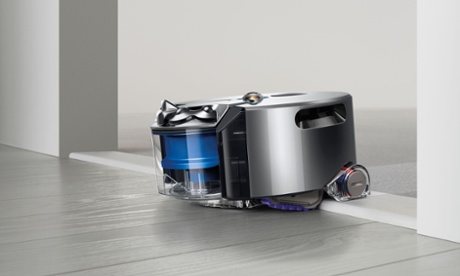
It has taken 16 years but James Dyson has achieved one of his dreams: to build a robotic vacuum cleaner. As befits a device of the modern age, it can be controlled remotely via a smartphone app – and reports on where it has been.
Announced on Thursday, the Dyson 360 Eye relies on two breakthroughs: a machine vision system that takes in a whole room from a single camera lens and a powerful lightweight digital motor that enhances battery life.
Sir James Dyson says that the machine vision system for the device – which was introduced in Japan and is due to go on sale in the UK in summer 2015 – will have applications beyond household appliances.
“We think vision is a technology of the future,” Dyson told the Guardian. “We believe it has other applications – that’s why we’re putting money into developing vision systems.” In February, the company announced a £5m investment in developing “intelligent domestic robots” with Imperial College, including work with Professor Andrew Davison, who developed 3D room-mapping using a single camera – as used in the device.
Dyson hopes the 360 Eye will allow people to abandon their manually operated vacuum cleaners and leave the robot to clean their floors while they are out. “People replace their vacuum cleaners roughly every six years on average,” Sir James Dyson told the Guardian. “This will clean the floor and you can use a light battery-operated stick-style cleaner to do the curtains, sofa and so on … Most robotic vacuum cleaners don’t see their environment, have little suction and don’t clean properly. They are gimmicks.”
While several companies have developed robot vacuum cleaners – including Miele, iRobot’s Roomba, Samsung and LG – they have gained little market traction. The Roomba has sold around 10m units since it was introduced in 2002. Dyson prepared a similar product in 2001 – but it had 84 sensors, two onboard computers and would have cost around £2,000.
The 360 Eye, launched in Japan – the world’s biggest market for robot vacuum cleaners – will cost around £700.
The essential vision system is enabled by a fisheye camera lens on top of the device that can see the whole room at once, analysing 30 frames per second of data to work out its position relative to corners and obstacles.
Coding this software took 31 engineers more than 100,000 hours – and used algebra, probability theory, geometry and trigonometry to generate information about the robot’s location.
The robot starts at a charging station attached to the mains and moves into the room’s centre, cleaning in a square spiral. It uses “tank treads” rather than wheels to avoid getting caught in deep pile carpets and to conquer lips or small steps. It has a “fall stop” system to prevent it tumbling down steps.
Dyson claims that its methodical approach to cleaning – rather than following a random path or long sweeps – means it can cover maximum floor area per charge and never goes too far from an area it has already cleaned. When its charge dwindles, after 30 to 60 minutes, it returns to its station, where recharging takes less than two hours and reports can be made its progress to an iPhone app that also allows the owner to set a schedule for the device. It then sets forth to clean the remaining space.
The company claims its innovations confer two advantages: greater awareness of the machine’s position and better cleaning power. Dyson says it has registered around 420 patents and patent applications worldwide for the 360 Eye.
Dyson said that the 360 Eye, known until now as Project N223, was the result of £28m worth of research and development by more than 200 Dyson engineers.

